What is Chadar Trek?
In Leh, the temperatures dip way below zero degrees in January and February. As a result, the Zanskar river freezes and forms a layer of ice called ‘Çhadar’, hence the trek is named Chadar Trek. The river flows through the Padum valley of the Zanskar region, in India. The word ‘Chadar’ in Hindi means ‘a sheet’.
What is the best time for Chadar Trek?
Since the river freezes only in the winter months, Chadar trek is a winter-trek and is best done in Jan or Feb.
Where is Chadar Trek?
Leh is the town closest to the Zanskar river and is situated in Jammu and Kashmir, a state in north of India, at a height of 11000ft. When the Zanskar river freezes, it solidifies enough for one to be able to walk on it.
So, the Chadar trek is a stretch between Shingra Yokma and Nerak village.
Wikipedia
View this post on Instagram
How is the Chadar formed?
In the river flowing in the video below, notice that it has some frozen pieces of ice. These pieces of ice are wispy and delicate. Depending on how the river curves, the pieces of ice sediment on the sides. Over a period of time, this sedimentation becomes bigger and bigger. When the temperatures go lower, it hardens the structure further, forming a sheet of ice. Gradually, this is how the Chadar is formed.
Chadar Formation on Chadar Trek
“Fasten Your Seatbelt, Please.“
Our aircraft prepared for a landing at Leh airport.
“Baahar ka taapmaan shoonya se nau degree neechey hai (the temperature outside the aircraft is -9° Celsius)”, said the lady on the announcement system. I let that sink in as we readied ourselves to deboard at Leh Airport.
The sun had been deceiving us for the last hour.
As our plane wheeled to a halt, the rays streamed harder through the window. It was difficult to imagine that it was “shoonya se nau degree neechey”(-9° Celsius). In fact, for the last twenty minutes, I had been squinting through the view as the brightness and clarity were overwhelming. It was almost as if highlights and shadows had gone wrong, in photography speak.
When I had left Delhi a few hours ago that morning, I was dressed for 8°C that Delhi was on that densely foggy morning.
As we got ready to deboard the aircraft, the guy next to me sat typing furiously on his phone. His phone screen had a Whatsapp group chat titled ‘Chadar Trek’. So did the guy next to him. And the entire row of people queued to deboard the aircraft.
When you are in a situation like this, make note of the faces around you. These are the same people who you’ll bump into throughout your trek, and later during your return flight. In a nutshell, these people will form your society/tribe for the following week or more. Be nice to them; they will need you and you will need them.
While deboarding the plane, I tried to work out how to contact my group members who were to arrive around the same time as me. (Got to know later that four of them were in my flight only— this is how I suck at WA group-chats).
My phone which has a prepaid number had gotten reduced to being just a camera. It continued to be so for the next ten days. (The kind of workaholic I am, that is the only way I can stop working).
The minute we stepped out of the plane, the seriousness of -9°Celsius hit me hard in the face! Literally and figuratively.
Since I had no checked-in luggage, I walked out of the airport within three minutes of deboarding. The folks managing the boarding process in Delhi had let me carry my entire luggage as hand baggage. This was completely opposite to what I had heard about the flights to Leh— that you cannot carry anything as hand baggage, and everything ought to go as check-in luggage.
Leh airport is a lot like those small-time airports (like Bagdogra) that also double up as a defense base. (Or is it the other way round?) Unless there is a flight coming in, the arrival section is more or less deserted.
As you step out of the airport, you are suddenly surrounded by taxi drivers and fleet operators. Everywhere else, this annoys me to the core but here I was thankful. They offered me their phones so that I could call our team lead and the other trek mates who arrived at the same time.

A phone call peppered with some “where are you?”-“I am next to this”-later, we met.
These guys, in spite of hailing from cities that see ’22°C of extreme winters’ (at least two of them), were way better equipped to handle the wrath of the icy cold winds than I was. Or, probably because of that. And they wanted to have a leisurely coffee. Unfortunately, they had to hurry up because I felt my face would go numb any minute. These guys were a real gem of fellow travelers, I discovered in the days to come.
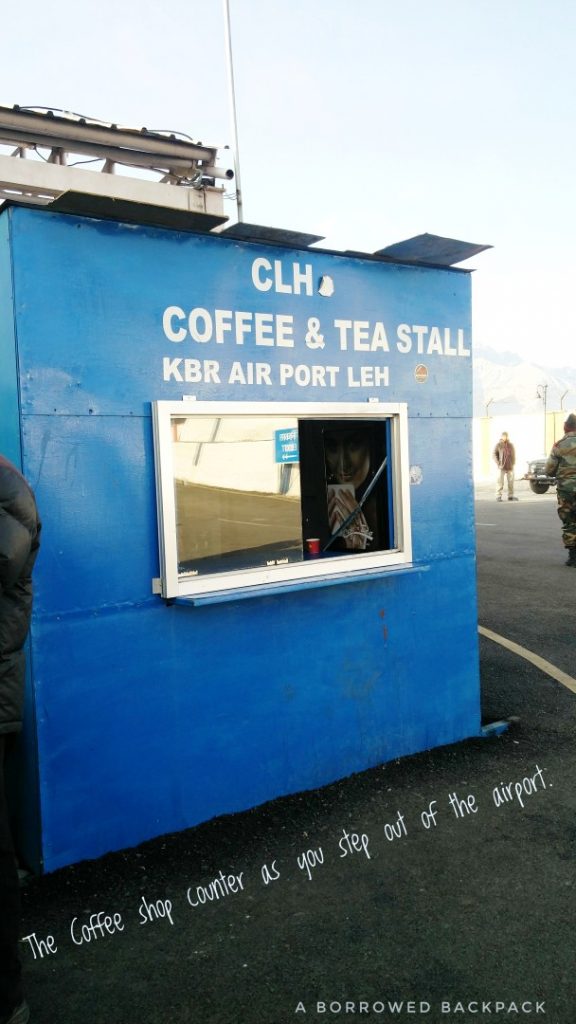
A few minutes later, we packed ourselves in a taxi, with our rucksacks over it. Five breaths later, we were outside our hotel called The White Yak. This is what I love about small towns.
The hotel had a room with a community fireplace, and as soon as I spotted that, all was and were forgotten.
I had traveled with complete strangers earlier too (Spiti & Jibhi), but this felt like something I had never done before. Probably, because these trips happened five years ago and I am hooked on to traveling solo since. It took me some time and internal conditioning to get used to having people around me all the time. Or, factoring them in when plans were being made
For the initial few hours, I could not understand whether to make note of the fact that:
- I had to stay up (I had slogged tirelessly at work, and while prepping for the trip. I was dying to sleep), or
- I had to breathe deeply (so that the oxygen level stays optimum), or
- I had to guzzle water by liters (for the same reason), or
- I had group members as fellow travelers this time. And that, they have names, and ought not to be addressed as ‘the one who was sitting here in a gray jacket’.
This entire thing had thrown me off my mental, emotional and intellectual balance beyond my wildest imagination. Little did I know that this was just the tip of the iceberg.
The Sweet Beginnings Of Chadar Trek
Enter our Trek Lead, His Highness Lokesh. He explained to us that the next 48 hours were dedicated to acclimatization. He laid out a three-step road-map for the same:
- Drink lots of water.
- And then some more water.
- And when you finally can’t take in anymore, chug another liter of it.
This directive works well until you have to leave the cozy place next to the fire pit to pee, double the number of times. And that, my friends, is a trek of another kind, which I will come to later.
Day 1
Hotel, Leh
(Day -7°C, Night -12°C)
Took one moment at a time that morning.
Suddenly, we heard the national anthem being played at a school nearby and it dawned on us that it was Republic Day.
The rest of the day went cozied up in the community room, understanding what lay ahead. For example: learning to use the bathroom was an adventure in itself.
For a lot of people, Chadar Trek begins at Shingra Yokma. Or somewhere close to it. For us, it began at our hotel washrooms in Leh itself. Any droplet that fell on the floor, froze and turned into a layer of ice instantly. You glide around on the ice, hoping not to fall.
Before one entered the washroom, they had to plan the entire course of action step-by-step.
The bucket and mug are kept too far from the pot?
Forgot the toilet paper in your luggage?
Or, is it placed too far?
The water in the bucket went cold, and formed a thin sheet of ice over it while you were planning all this?
Your butt froze with its first contact with ice-cold water?
Good luck with situations like these.
It will take a blunder or two for you to arrive at the right process flow. Needless to say, our daily ritual got reduced to, well, the absolute necessities.
After asking “what temperature must it be now?” every fifteen minutes, and being dismayed at the fact that it was ‘just’ -10° Celsius, (when it actually felt like -100° Celsius), the day finally came to an end. It was advised to us to get restful sleep at night so that the body could acclimatize better.
Each of us had heaters in our rooms but most of us decided to not keep them on for the entire night. We wanted the atmosphere to be as close to what we were to experience during the trek. It was Day One of subzero temperature. The learning curve for the body and the mind had been very steep, but we winged it somehow.
Day 2
Hotel, Leh
(Day -8°C, Night -12°C)
By the second day, I was perpetually hungry.
I was still getting used to the fact that the meals would be served at stipulated times of the day. I tried telling myself that there would be no free-wheeling on the food during the Chadar trek.
My brain had understood that; if only could my body cooperate.
Apart from that, I wore absolutely everything I was carrying. Since my backpack became sort of empty, I had to do something about the empty space in it so that the stuff doesn’t move around and remained still. After trying to work it out for an hour, I gave up.
And after giving it some thought, I proposed this to my roommate: we carry one rucksack for both of us if her stuff too didn’t need an entire backpack. She did her math about the same, and we took one backpack for the trek. We left behind another one in the hotel locker room.
Most of my things that needed space were electronic items. They had to be wrapped in woolens; camera, phone, camera battery, torches, lenses, power bank, etc.
The day was also dedicated to last-minute shopping like gum-boots, some snackables, trekking-pole, sunscreen etc.
Day 3:
Leh-Shingra Yokma (Chadar Trek)
(Day -8°C, Night -17°C)
The drive from Leh to Shingra Yokma takes roughly two and a half hours. As we reached Shingra Yokma, the reality of the Chadar trek being the modern-day Kumbh ka mela hit me hard. There were Tempo Travellers all over the place, queued up to deboard the travelers and their entire haul.
The area where the tents were put, was packed with groups of trekkers. Travelers traveling with various trekking companies mingled seamlessly with each other, forming a huge mass of humanity.
Technically, this was our Day 1 of Chadar Trek. It was a very windy evening— as if someone had left the door of the freezer open. The shit had got real.
This is also when you learn:
- How to penguin-walk (I don’t know why the walk is named after penguins, as they themselves don’t walk like that). If all goes well, you would also lose your ‘Chadar virginity’, and skid and fall at least once before you have mastered the art of dragging yourself on ice.
- How to figure out a peeing/pooping spot when everyone around you is doing just the same.
- That the tented toilets at Chadar Trek are a fictitious facility. In fact, the toilet arrangement in the entire trek is extremely pathetic. I have no clue how the authorities are sitting blind as a bat over this! How can they be letting people poop all over the frozen river itself?
The Chadar melts and becomes a part of the Zanskar river, which is consumed unfiltered by the villages and tourists alike.
- Your personal calculation about stuff like: ‘how badly do I need to pee?’ ‘how many hours before bedtime do I limit the intake of water?’ (and yet not be dehydrated the morning after)? so that I don’t get the urge to pee after I finally hit the sack and definitely not once I have figured out my most comfortable position in the sleeping bag?’
- That the nights are extremely cold, and one tends to layer up in bulky clothes. This kind of layering up leaves hardly any space to move around in the sleeping bag, but one also needs to figure out their ‘comfortable side’ to sleep well.
This was the evening when one good Samaritan taught us a game called ‘Mafia’.
It became the ‘cozying-up-with-my-current-favorite-series-as-soon-as-I-reach-home’ equivalent for our entire trek. From here on, we would reach the campsite, throw our stuff into our respective tents, and join everyone in the dining tent for this evening ritual.
Each one of us had a twin occupancy tent.
This was also my first experience of using a sleeping bag.
That night when we went to the bed, it took me an hour to get comfortable with the idea of being zipped up in a bag. The hood covered my entire face which made me very uneasy. Within five minutes of lying down, I became acutely claustrophobic and panicked! I struggled to wriggle out of the sleeping bag. It didn’t help that the entire thing moved with me, but wasn’t letting go of me. Or, zipping down. I remember sitting up, with the damn thing still zipped up right up to my nose, and my arms swaddled inside it. I found it difficult to breathe because of the extreme exhaustion and the mild fever that I was running.
After a few minutes of struggle, I gave up and flopped back to sleep. Sometime in the middle of the night, another panic attack (because of claustrophobia again) hit me hard. I sat up all sweaty, wanting to scream but my vocal cords failed me. That was the moment when I thought – ‘To hell with zipping up the sleeping bag!’. SOMEHOW, I unzipped that entire thing, freed myself and rolled up the hood into a pillow, and lived happily ever after.
Shingra Yokma campsite: The place is sandy and it makes for a very cushiony bed.
Day 4:
Shingra Yokma- Tsomo (Chadar Trek)
Distance: 10 kilometers
(Day -10°C, Night -19°C)
Number of falls-0
“Hurry up, Divya! We’ll be leaving in forty-five minutes.”
I opened my eyes to Lokesh waking us up. And to a chunk of frozen frost, in the curls of my hair that had strayed over my face (more specifically, my mouth), at some point during the night. The frost was from the moisture in my breath that had gotten trapped in my hair.
Upon waking up, the first thing you are served is warmed water which is mildly sweet.
Next up, would be the following struggles:
- Locate the toilet paper (and not wet wipes).
- Get out of the tent.
- Wear the gumboots that would have become wood-like due to cold temperatures.
- Scout for a potty-spot (this is an art).
- Come back and get ready before the tents are taken down.
- Have breakfast.
- Get going for the day.
We started from Shingra Yokma at 7:45 am. The sun was up in the sky, but the winds were VERY cold and harsh.
The vicious cycle goes like this-
- you slow down because it is too cold,
- when you slow down, you tend to feel colder, eventually heading towards numbness.
As per our trek lead, the only way to counter this was to walk faster, against all odds. It took me a while to internalize this advice.
The point to understand here is– since you walk on a river that is wedged in a valley, it would be only after 11:00 am that you get some direct sun. Until then, it is all bright and sunny with ambient light all around, but you walk in the shadows of the mountains that tower over you on both sides.
Add icy cold winds to the effect. Even when you do get some bit of direct sun, the chilly breeze makes it just about enough to warm the soul.
You try and hold on to the warmth in your soul until it is time for the bonfire at night.
After walking for around four hours, we stopped for a lunch break. Thankfully, our lunch breaks were always at sunny spots, where we would sprawl out without a care. During these breaks, we also removed our shoes and dried our socks. While trekking, the socks get soaked in sweat and often become the cause of cold/hypothermia.
This shot was from the place where we stopped for lunch (to understand how grand this was in reality, check out how tiny people look here:
For some reason, when we reached Tsomo, I was very, very cold. Like, numb with cold; no amount of layering up helped! I decided to stay in my tent for some time; I anyway wanted to die in peace, and not while playing Dumb Charades/Mafia.
It was one of the hardest nights for me but two nights after this, I figured out where I was going wrong.
Tsomo is a cliff-like campsite, with a mix of rocky and sandy ground.
Day 5
Tsomo – Tibb Cave (Chadar Trek)
Distance: 11 kilometers
(Day -12°C, Night -24°C)
The number of falls-1 (And that changed everything for me for the rest of the trip).
We started at 7:00 am, and as always, I was semi-frozen. Lokesh tried to thaw me by encouraging me to walk faster.
As we gained pace, we reached a layer of ice that was extremely slippery and had a slight ascent. Since it was a tricky patch, three of us walked gingerly in a queue.
I don’t know how it happened but within seconds, three of us slipped one after the other, and each fell as a result of the person ahead of them slipping and hitting them on the way down. It was like a pack of cards coming down in a cascading effect.
Whatever it was, this is how it impacted me– as I fell down, the strap of my backpack shifted from my shoulder to the nape of my neck, and weighed down heavily on it. This triggered a spondylitic pain of the worst kind, and what happened in the next half an hour was extremely agonizing. As a result of getting hurt near the region where spondylosis impacts, I started to get a headache in the back of my neck, and the pain traveled to the top. Soon, I was giddy. Also, a slight numbness coupled with a tingling sensation started spreading in my left arm. Within fifteen minutes, I started to feel pukish. This alarmed me a bit, as headache, nausea, and giddiness are also the symptoms of AMS (Acute Mountain Sickness). AMS or no AMS, I knew from that moment onward, my struggle was going to be of a slightly different nature.
I can go for YEARS without any problem with Spondylosis, but once it gets triggered (which is mostly in winter), it takes around 10-15 days to settle back to normal.
Since my speed deteriorated drastically after this fall, Lokesh sent for crampons from the other batch. That batch was trekking with the same schedule as ours, but with a different trek lead.
I will talk about crampons a bit later. Here is what it looks like:

The lunch spot for the day was across the river. The way to the other side of the river was a patchy stretch of semi-frozen width of river. One had to cross a small area of not-so-strong Chadar, and a bit of water to reach the other side. As soon as we halted, most of us looked for our kind of spots and became beached whales atop big rocks.
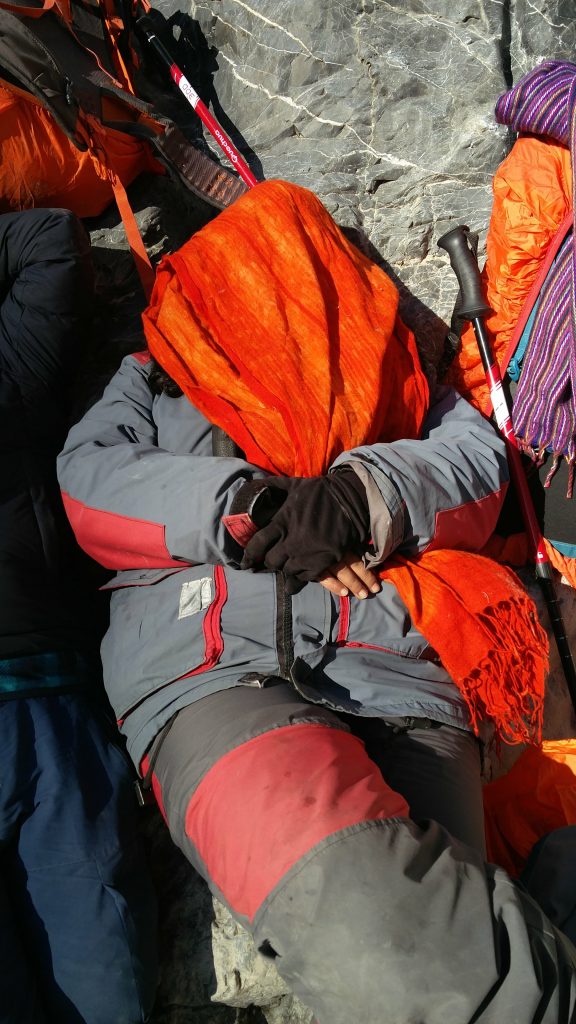
Also, I think by now, I had lost one of my day gloves (black, silk ones), and had to wear mittens even during the daytime.
When we started from the lunch-site, I had to hand over my day backpack to the porter. My shoulders had completely given up after the fall. I could sense a rigid heaviness, and that area had swollen. Thankfully, we had covered 70% of the distance for the day.
Just before the campsite, we had to take a minor detour from the rocky area, as the Chadar formation was weak. This is one of the most beautiful and consistent inconsistencies of the Chadar Trek.
By 4:30 pm, we had reached Tibb’s Cave campsite and the first thing I did upon reaching was— scout for a location, get our tent set up, and lie down for a while. For some reason, time really moves very slowly in the moments like these. If one had been lying for twenty minutes, the damn thing felt like two hours! The nights crawled at an even slower pace but then who could blame it— cold does slow down breath and death.
Right across the place where our campsite was, there were caves made high up in the mountains! At first, when I saw them, I thought they were uninhabited, or if they were caves at all (I have marked them in the picture below).
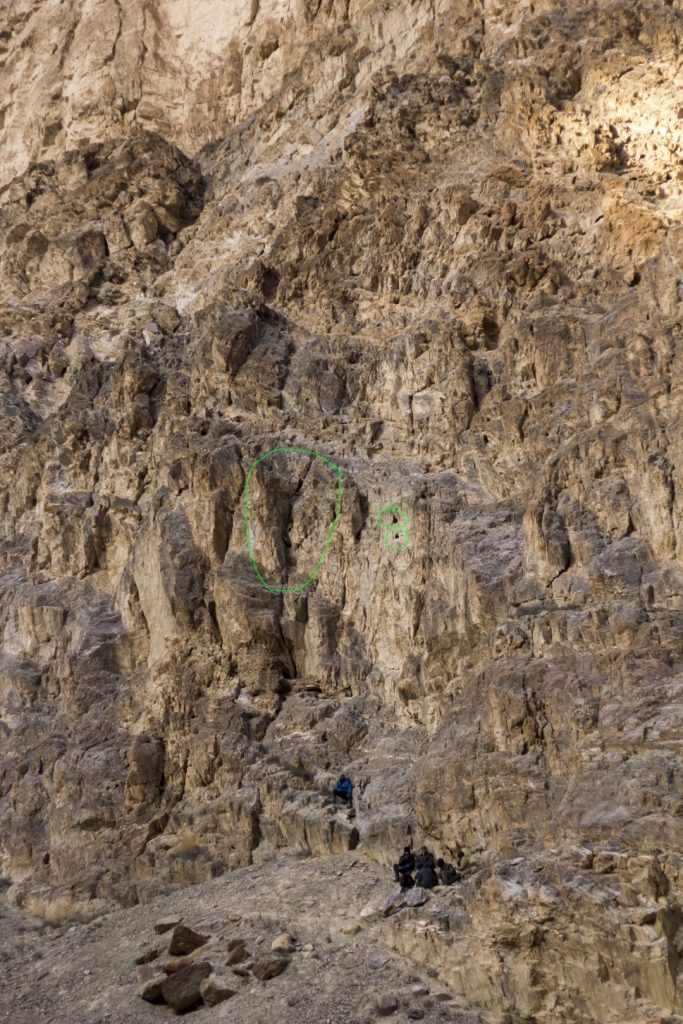
And soon after, all my doubts were put to rest, when I saw these local folks climbing down a mountain that was almost perpendicular to the ground!
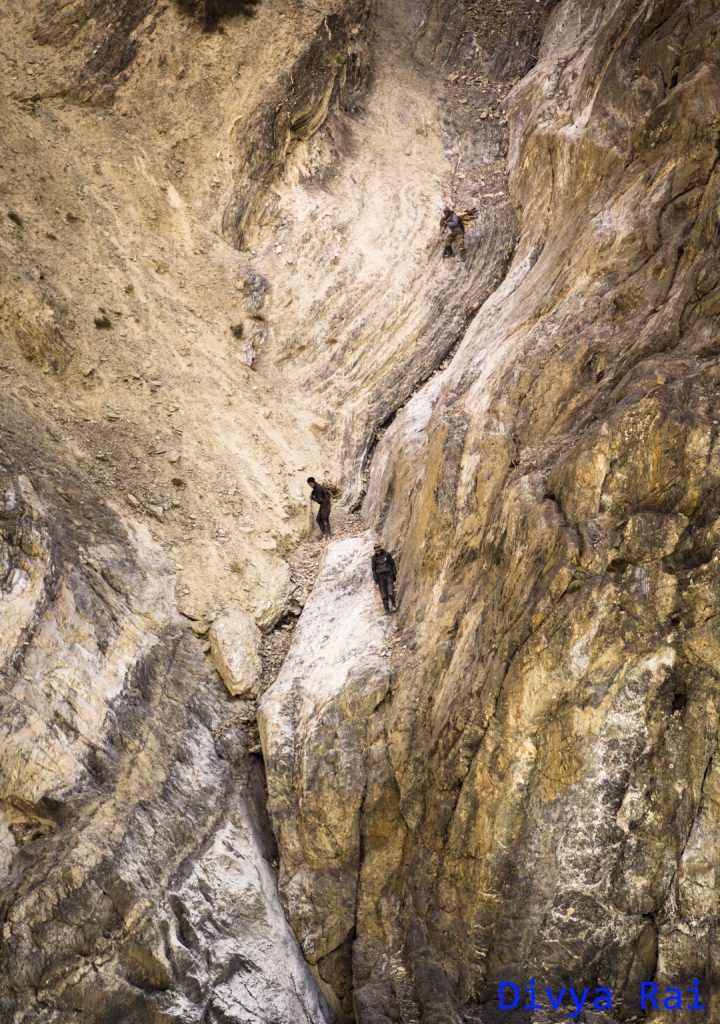
By now, everyone in the group had an ‘upon reaching’ routine for the campsites:
Sooraj would remove shoes, socks etc, dry them out, freshen up and zone out.
Pushkar would sun the socks, mattresses, thermals etc for Pratiksha and himself. He not only laid those out, but also moved them along with the sun. By the end of the trek, his skill equaled those of the mountain goats. You would look high up a mountain slope at ~90 °, with a couple of mattresses drying on top of it, and wonder how did somebody reach there. Half an hour later, Pushkar could be seen scaling the damn thing with complete nonchalance to collect everything and put it back in the tent.
Pratiksha is an excellent singer and we got to hear some beautiful songs during the bonfire sessions. Her mellifluous voice soothed the harsh nights at Tibb Cave and Gyalpo Campsite on our way back. You can subscribe to her Youtube channel here.
Rupesh was my go-to person for photography as he is a hobbyist. He traveled with every possible lens and gadget one could need during Chadar Trek. For that alone, he deserves massive respect. His ritual was to figure out how cloudy the sky was and what would the vantage point be, to shoot at the campsite each evening.
He, probably, has every bit of the trek documented in photos and videos.
Prageet and Roneet came into full bloom only during the bonfire sessions, where they basked in the spotlight with songs that we aren’t likely to forget in a hurry. “I am a hunter...” from Gangs of Wasseypur was one of the favorites and was crooned at all appropriate and inappropriate times of the day.
Appropriate time: Bonfire.
Inappropriate time: While trekking, we reach a slope from where one could slide down either sitting or standing. Roneet chooses to do that standing but falters slightly towards the end.
Us: Roneet, you ok?
Roneet: I am a hunter…
Shevanti would potter around, infusing the air with light-hearted banter that was much welcomed after the long day. It was a time reserved for jibes, suggestions, and general chit-chat with everyone.
Anas and Ashok ji were not only tent-mates but also had very similar temperaments— silent and resilient, rarely making a song and dance about their zero-fall days. They almost faded into oblivion until it was time to play ‘Mafia’, where they were voted out in the first few rounds nearly every time, all thanks to what they ‘looked like’— silent and resilient.
Rakhee ji, my tentmate, would kick-start the Mafia sessions whenever and wherever they happened.
Vaibhav was the one-liner guy in the group.
Imagine this: minor catastrophe, immediately followed by a shocked silence from the group, almost simultaneously followed by a punchline from Vaibhav.
The person hit by the situation would double up with laughter, even if tears streamed down his/her cheeks due to whatever pain he/she was in.
Apart from this, Prageet, Ronit, Vaibhav, and Rupesh can easily put beauty bloggers to shame, if they ever decide to host a spoof channel for the beauty niche.
Never had I, in the history of men using lip balms, seen men/boys use it directly from the chapsticks. (The ones I know are a slave to their machismo, and usually, take some of it on their fingertips and then apply it to their lips.) These guys, clearly, weren’t from that universe, and that was a refreshing change.
After resting for twenty minutes, Lokesh advised that I move around a bit, or else the pain could get compounded later. I took his advice and accompanied Rupesh, Vaibhav, Anas, Roneet, and Prageet to Chadar; they wanted to click some pictures of the landscape before the sunset. I had some products to shoot for one of the clients I was in a consulting role with, and the evening seemed like a fine one to do the shoot.
I strapped on the crampons and we descended on the Chadar.

Now, it is one thing to do product photography everywhere else, and quite another to do it on Chadar. Your knees wouldn’t bend beyond a point, or for long.
You remove mittens every time the settings of the camera need to be changed and put them back on hurriedly once done. And I will not discuss the arduous process of changing the lens.
Added to all this, your hands aren’t steady enough, and you look for a rock to use it as a tripod, but then the backdrop from that particular rock that is acting as your tripod is too cluttered, so you look for another rock to place the product on (but with a cleaner and more manipulable backdrop).
Then, you lock your focus on the brand-logo of the product, but you realize that the product should be turned a bit more toward the left.
You then leave the camera and walk up to the rock, on which the product is placed, only to realize that the Chadar formation around that rock is recent and weak, and is cracking under the weight of your body, or the impact of the claws of the crampons.
Almost instantly, you regret not getting your hiking pole, because that is how one checks for the quality of Chadar formation.
You move quickly from that place and look for another rock to place the product on.
While all this had been happening, the sun sneakily slipped behind the mountains, and you then chase the fag end of daylight with the remaining ambient light.

Ten minutes later, Rupesh & Co. were done with whatever they were trying to capture, and they waited for me to wrap up.
Twenty minutes later, we headed back up to the campsite, which, by now, had set up the dining tent.
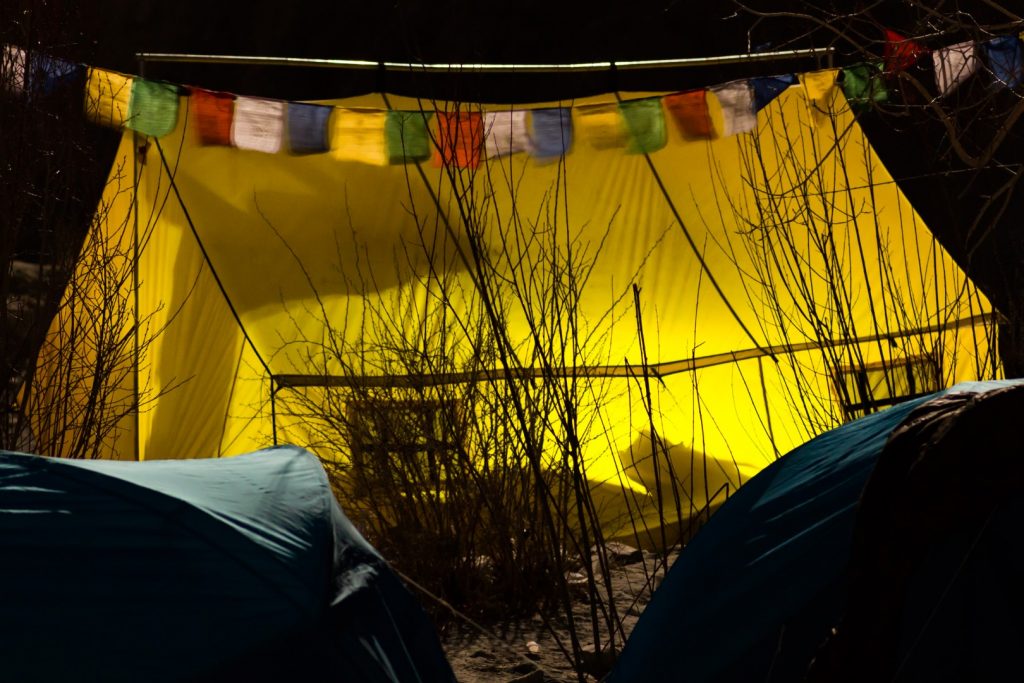
Except for this day when I waited until that moment, the first thing I would do upon reaching the campsite was: zip up the tent and change into a fresh pair of undergarments, and put everything back on. Every. Single. Day. The world can laugh at me for this, given how cold it was, but a ritual is a ritual.
This day was no different except for the fact that while changing, I had a eureka moment— when I touched the inner side of my thermals, they were slightly damp. That’s when I recalled that Manas Malara (a friend who had done self-sustained Chadar Trek the previous year) had SPECIFICALLY advised me to change the inner layer of clothing and socks as soon as I reached the campsite. I had, somehow, forgotten this bit of advice. From this day onward, I implemented the same and was a lot less cold during our night halts.
That evening, I did not feel so cold, but the pain from the fall surfaced the minute my back went horizontal at night. My tentmate had applied Volini on the affected area, but this was a pain that stemmed from my soul, it seemed. As far as I remember, I slept and woke up in the same position. I was slightly skeptical for the following day, as the distance to be covered was maximum, and my body’s ability for physical endurance was at its minimum.
Tibbs’ Cave Campsite is a sandy campsite. It made for a very comfortable bed at night. Some people camp in the caves, I have heard. How, is beyond me; given how difficult it is to sleep on the rocks, as they go damp and very cold at night.
Day 6
Tibb’s Cave Campsite- Naerak village (Chadar Trek)
(Day -9°C, Night -19°C; Cloudy)
Distance: 14 kilometers
We started at 6:45 am and surprisingly, covered a decent distance by lunchtime. Why not; after all, we had begun our day with poori-chholey as breakfast! The day was made even before it had begun.
On our way to Nerak, the Chadar formation was non-existent at two places, and we had to climb the rocks and take a detour. The day was cloudy and slightly warm-ish for Chadar.
Nothing uneventful happened throughout the trek that day (thankfully!).
The river flowed with full rage alongside. The Chadar formation was fairly narrow in most places. By then, everyone had a bit more grip on the walk, and the number of falls had reduced significantly.
That day, Anas and I walked together for most of the distance, and we took turns doing this:

Four or five kilometers before Nerak, we chanced upon some snow and a fun idea that turned into a sorry situation at an alarming rate.
A bunch of us scraped off some snow and hid behind the boulders to attack unsuspecting oncoming group members with snowballs. All was fun and games, until Lokesh, our trek-lead, was the only one left to be attacked.
Everyone hid and threw the snowballs almost simultaneously when he showed up. Because of some calculation error, one rather hardened block of snow hit him at the corner of his eye, and THAT immediately set all of us straight! How sorry we were about the accident (no matter how-so-ever small), cannot be stated here in words.
After that, we just behaved ourselves and walked.
As we approached Nerak, it looked like it might start snowing any minute. Added to that, the group had planned to go to the frozen waterfall on the other side of the Naerak village— a ‘must visit’ for Chadar Trek, as per the internet. So, we huffed and puffed for those last few kilometers.
Minutes after we reached Naerak Campsite, it started to snow a bit and the group left for the waterfall.
I decided to stay back as I was feeling a strange pressure on the sides of my nose. Even when I was debating with myself over this in my tent, my body refused to listen beyond, “Should I go to…”, and I decided it is better not to push it beyond its limit.
This is what I did when I was at the campsite:
https://youtu.be/NZHpNHBofCA
With time at hand, I also got to hang out with the kitchen staff that evening. And discovered the things we take for granted back home, and the kind of effort it took to do the same things in that temperature.
This was canned raw material like mushrooms and cherries being de-iced for usage:
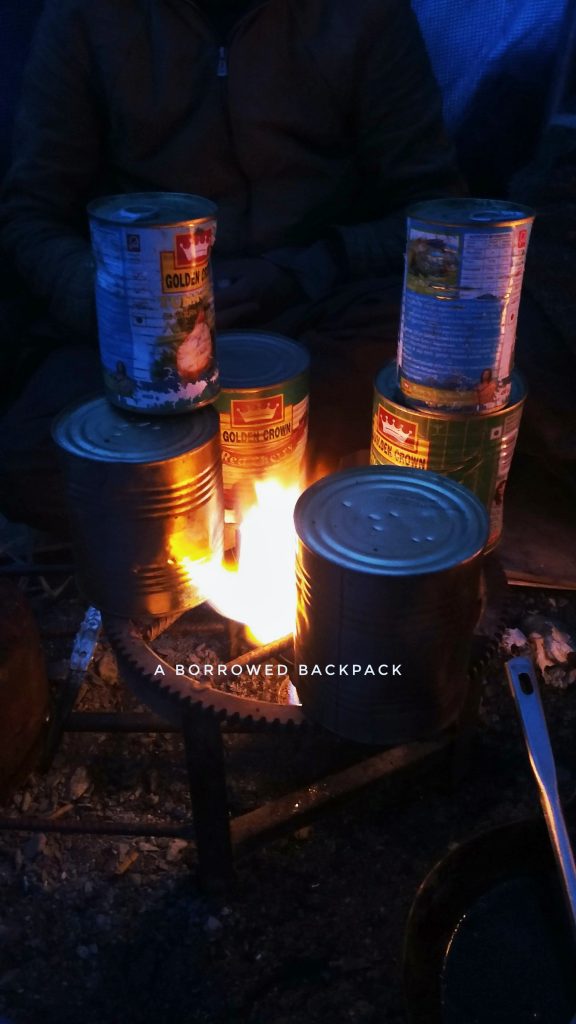
Here is a frozen onion before it could be cut:

Can you see how the onion is covered in ice/frost? Not only that, the juice inside had frozen too!
Every evening, before these could be chopped up, they had to be kept on a plate that covered a pot of rice that was being cooked for dinner. The plate was hot and it helped in thawing the onion enough to be chopped. Sometimes, this simple process took about twenty minutes.

Chopped onions. Can you see the glistening shreds of ice?
Look at the chopping process in this video; the core was still slightly frozen, hence it took some effort.
The night we stayed at Nerak village was the one when all of us were too tired. The additional activity of going to the waterfall had exhausted everyone enough to hit the sack early that night.
The rocks on which our tents were pitched became so cold at night that, when we laid down, it felt as if our sleeping bag and lining-mattress were soaked in cold water! This is when Anas offered that I take a Warmee from him and sleep with it under my back.
Added to this, the night was so windy that at one point, one corner of our tent came undone against the pressure of the wind! It was one of the noisiest nights (because of the wind) of the entire trek.
In the morning when we woke up, the mattress was completely wet and all the pain from my fall had resurfaced. Needless to say, I was very slow in getting ready that morning.
Nerak campsite is a rocky one.
Day 7
Nerak Village-Tibbs Cave Campsite (Chadar Trek)
(Day -10°C, Night -33°C)
Distance: 14 kilometers
Nerak village campsite is also one of the most ‘shitted-out’ campsites of all places at Chadar Trek.
Poop-cakes welcome you when you enter the place, and those are the last things you see as you leave.
Our trek back to Tibb’s campsite was a blur. The weather was cloudy when we started but cleared up as we reached Tibb’s.
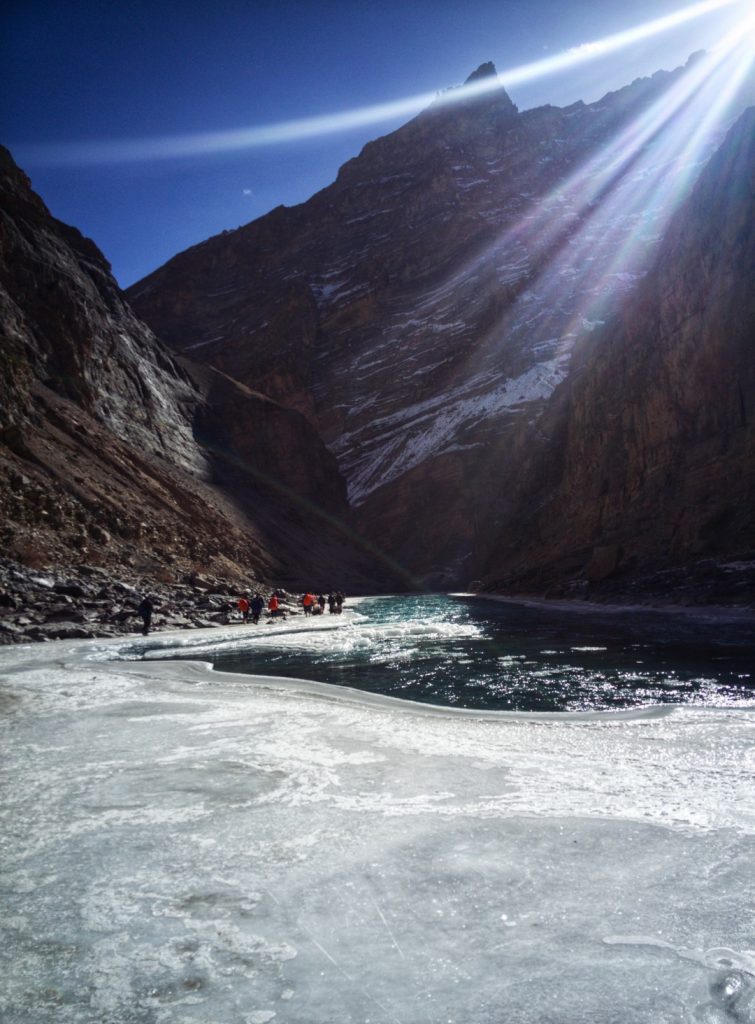
It cleared up with such a strong sun, that it got to some of us’s heads.
To my utter disbelief, a plan to do Tibb’s-Gyalpo-Shingra Yokma in one day started brewing up.
(As per the original itinerary, it required two days.) Tibb’s-Gyalpo-Shingra Yokma is approximately 19-20 kilometers.
Until this point, the maximum distance we had trekked in one day was 14 kilometers. (Tibb’s Cave- Naerak village).
I watched the entire discussion unfold in complete horror. The bunch that supported the thought forgot to account for ‘what if something went wrong’. Thankfully, they called in for votes in the end and the idea didn’t see the light of the day.
I couldn’t understand what was the hurry to go back about?! What were they missing?
Waiting in traffic jams?
Or the canceled rides by Ola/Uber drivers?
Or their bosses?
But this was also the point when we were kind of done with the entire monotony of the Chadar Trek, and couldn’t wait to get out of it. (This is the least discussed aspect in the business of painting the Chadar trek glamorous. I will take it up towards the end of the blogpost).
I was so done with it, that twice, I caught myself planning about ‘the topics we can work on’ when I report back to work again. This, clearly, had to be the newest form of low in my life.
View this post on Instagram
This was a remarkably and painfully cold night, where no amount of bonfire helped. Little did we know that we were looking at something to the tune of -33°C, and all the shivers were justified.
Had it not been for Rupesh trying to shoot star trails (or whatever bit of night photography he was trying his hands on), it would have been neigh impossible for me to survive without whining.
Day 8
Tibb’s Cave Campsite- Gyalpo Campsite (Chadar Trek)
(Day -7°C, Night -25°C)
Distance: 12 kilometers
The next day we woke up to an un-frigging-believably cold morning. It was a morning when we ran around like headless chickens!
We got ready somehow and started the day at 6:45 am.
As soon as we stepped onto the Chadar, the breeze hit us hard in the face. I turned to look at Lokesh with tears welling up in my eyes. Concerned, he asked me what had happened. I opened my mouth to explain my plight to him, but to my horror, my tongue didn’t budge! It had frozen! Thankfully, he understood without me uttering a word, and signaled that I walk.
Walk we did that day, slowly but steadily. The thought had shifted from the joy of going back home to surviving the moment at hand. It was one of those days when the day crawled at a snail’s pace. Thankfully, nothing uneventful happened during the day.
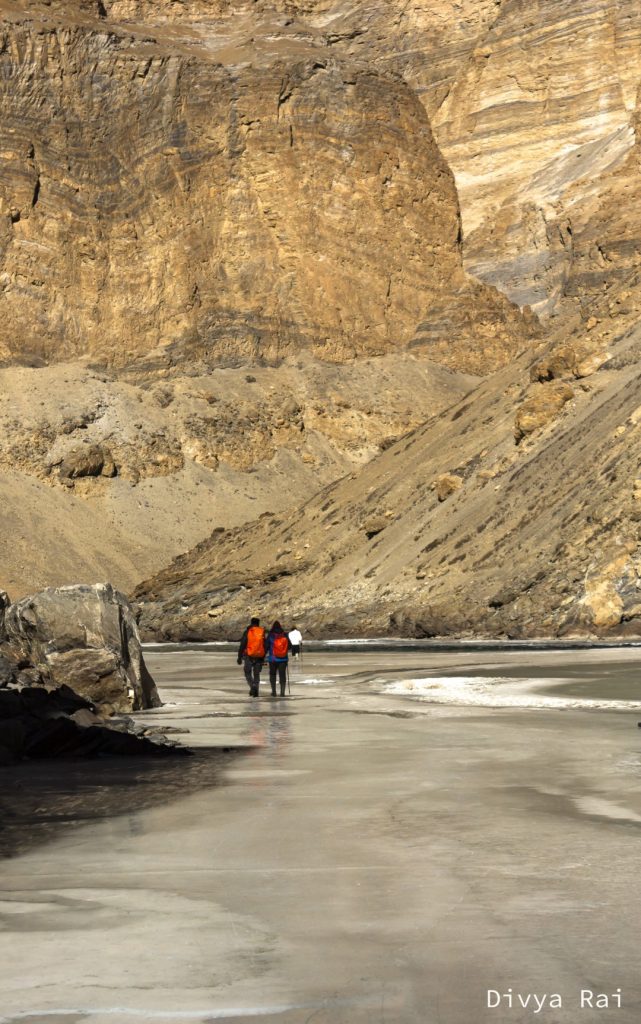
The night halt was at Gyalpo.
Upon reaching, as soon as I laid down in my tent and closed my eyes, I felt I was still standing. At first, I thought I am too giddy with exhaustion, but when I opened my eyes, the other symptoms didn’t corroborate. That is when I noticed that, of all the nights, this was the steepest slope that our tent was pitched on ever.
The general rule of thumb about a situation like this is- your head ought to go on the higher side, and the legs on the lower side. While lying down I felt that the slope was somewhere between 15°-25° from the horizontal plane.
While I was busy experiencing this extraordinary ‘situation’, everyone else took a two-minute hike and went to a cliff-like spot next to the campsite. This campsite was a shared one and I could hear the other batch have a good time over ‘chai’
.
By this point in the trek, you’ve had enough of sweets, and the body c-r-a-v-e-s for salt. How badly, I understood it here. As I lay in my tent, I heard someone from the other batch shout, “Guys, come here, I have got ‘theplas’ with me.” I immediately collected my aching bones and got myself together and out of the tent in one minute flat. No, I wasn’t invited. All I wanted to see was: who this mahapurush was. Just then, Shevanti (or was it Pratiksha?) too stepped out of her tent and we looked at each other as if to ask- “did you too hear that?“. Both of us stood there and watched the other batch bond over ‘theplas’. They bonded the way you do over chai, beer, or wine after a particularly long day at work.
The thepla-owner was a guy who Shevanti, Pratiksha and I had collectively declared as the biggest lecher of the trek two evenings ago. The kind whose one glance can give you heebie-jeebies for a lifetime. Had he called us, would we have gone? In a heartbeat. Food is life.
We watched them have a jolly good time over theplas, with the warmth in our hearts the sky fading to be replaced by cold darkness by the minute. After this sorrowful page in the chapter, we decided to lift our spirits by joining everyone at the cliff.
At the cliff, we took a few photographs and looked for potential potty-spots (and the route we will take to reach there) – all on the pretext of enjoying the view. (This was for the next morning),
Once the recce was done, we trekked back to the campsite. As soon as we reached the campsite, for some strange reason, my nose started to bleed. I informed Lokesh about this, who immediately checked my Oxygen level, which was at 78%. At 70 %, they ask you to leave Chadar and head home; the good thing was, we were anyway heading home. After dinner, we gathered around the bonfire and sang some songs but I wasn’t feeling quite up for it. I requested Anas for a Warmee, and my tent-mate to apply Volini on the nape of my neck, and called it a night early. It was about 9:30 pm when I hit the sack.
Sometime in the middle of the night, I woke up dizzy. As I sat up, I felt that the insides of the tent were uncharacteristically cold. Also, I felt very thirsty and knew that the blood pressure in my body had dipped. Coupled with this, for some strange reason, my tummy started to rumble and pain terribly. Apart from this, I was sweating heavily and felt cold at the same time. To alert Lokesh, or not to alert him was the question. To do the former, I first needed to confirm if I really was dying, or if was it yet another round of introspection peppered with “what was I thinking when I took this up?” bout of hallucination. I took the toilet paper (just in case) and decided to get some fresh air. At Chadar, you don’t ‘just go for a walk’. You consider every possibility and minimize expending useless effort— toilet paper, torch, thermos, gloves, etc. As I was unzipping the tent, I discovered two inches of unzipped area from where the air must have seeped in all through the night.
It explained the cold temperatures inside the tent, and it also confirmed that I wasn’t dying. Due to lowered blood pressure, I felt so uncomfortably hot, that to cool off my body, I let the icy breeze hit my bare tummy for a bit. Five minutes later, I experienced one of the worst upset tummies of my life ever! After that, my body felt dehydrated.
Since all the water in my thermos flask was consumed, I decided to take a refill later when the kitchen staff was up. With the tummy discomfort gone, my body felt a lot better. Sweating too had stopped, so I decided to head back to the tent, and sleep some more. I felt very weak at that moment.
As I walked toward our tent, I checked my phone for the time. Surprisingly, what looked like ‘the middle of the night’, was actually 5:50 am. Since I could have gotten ready, brushed my teeth, and left for the day without having to scout for a potty-spot, I could sleep some more.
I went inside the tent, but by then, my dear tent-mate had slipped down the slope. She was still inside her sleeping bag but with her legs outside the tent. I struggled to zip the tent up by stretching the whole thing around her body. After trying for a while I woke her up so that she could adjust herself. She had slipped out owing to the steepness of our sleeping position if you haven’t already understood the reason.
Gyalpo Campsite is a rocky one.
Day 9
Gyalpo Campsite– Shingra Yokma Campsite- Leh, Hotel.
Distance: 9 kilometers
(Day -7°C, Night -20°C)
We had walked for about two hours when Pratiksha started to experience breathlessness.
The group stopped immediately and Lokesh checked for Pratiksha’s oxygen level. It was at a healthy 92%, but we took slightly slow from there on. We took enough breaks to do impromptu jigs once in a while as we were finally going home!
By 3:30 pm, we had reached Shingra Yokma. One by one, everyone except yours truly did the customary dip in the freezing water, after which we headed back to Leh.
Do(s) & Don’t(s) For Chadar Trek:
- Heater/fireplace: Even if your hotel has a fireplace or your room has a heater, try to use it as little as possible. This is easier said than done though- if I could, I would have sat on top of the closed fire-pit. The thing with room heaters is— your body takes that temperature as the average one and acclimatizes according to it. In reality, Chadar is way colder. Some nights, you will be right next to this:
Secondly, the constant heat dehydrates your body, making it difficult for the body to acclimatize.

- Book your hotel in advance. I cannot stress this enough. Almost the entire of Leh shuts down in winters. One of the few hotels that are functional in winter is White Yak. If you are considering going in the winter months, book a room for yourself here as you read this. Leh is not a city where you can spend your night without a roof over your head.
- No alcohol, no cigarettes, no smoking up. At least, not when your body is acclimatizing for Chadar Trek.
- If peeing and pooping in the open is an issue for you, you ought to rethink the whole deal. The tour operators will sell you the ‘toilet-tent’, which is one of the biggest shams of Chadar Trek.
- Your peeing/pooping spot: Figuring out the biggest rock in the entire landscape will not work. In all probability either
someonethe entire planet would have already pooped behind it, or someone you know could be at a location way higher than yours, with you in direct line of their sight. This math seems complex initially. After a point, you will learn toworkit outstop caring about it. - Taxes v/s Facilities: For Chadar Trek, you will be charged ~ Rs.2100/ person. This would be for ALTOA Permission, wildlife tax, environment tax, forest permits, and camping charges. These taxes are the biggest scandal by Ladakh Tourism department. The entire Chadar region has absolutely no washroom facility, thereby leaving the entire trek to be treated as an open loo. People poop all over the Chadar, and drink the same water unfiltered once the ice melts. Let’s not even talk about the littering on Chadar! I have no clue why no one has filed a RTI to figure out what is happening with all the money the government is making from the Zanskar region alone!
- Pee-Poo Breaks: You will be stopping many times to pee, given the amount of water you will need to drink. Unless you have a Pushkar in your group, consider getting a Urination Device. It is for a blessing for women (or people who are AFAB).
You can choose one from the list here. I have been using it for a while, and I regret not discovering it earlier. I carry it everywhere with me now, even to my shoots!
Tip: Buy the one with the box; makes it hygienic to carry. I have the one from Shewee. Also, make sure that the extender is long, or else your shoes/pants will get wet.
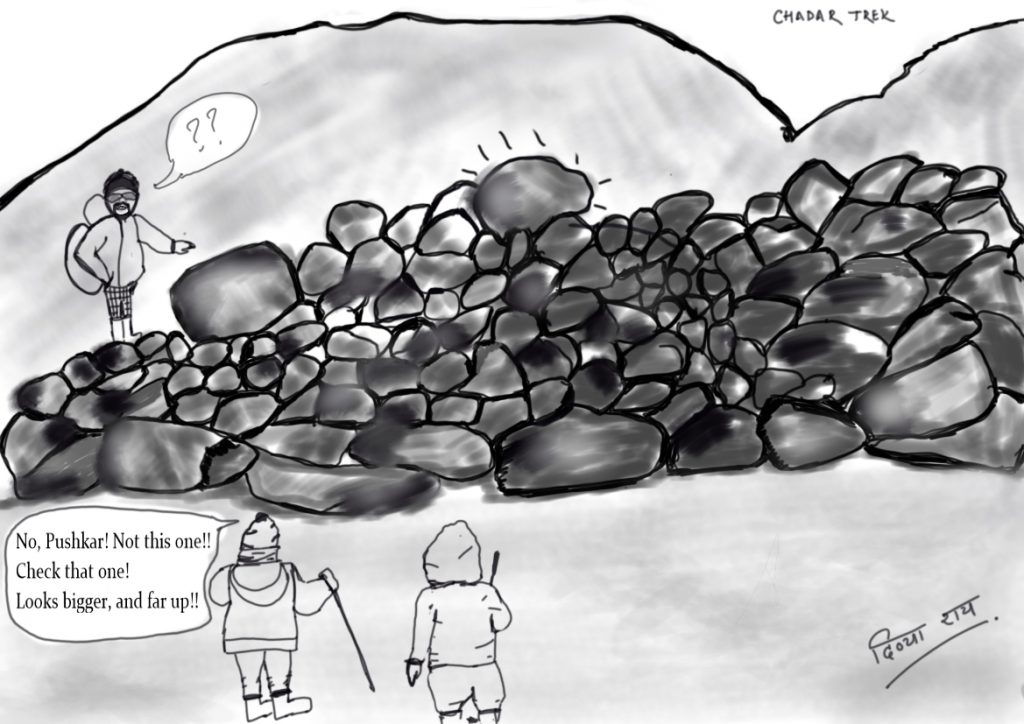
Crampons for Chadar Trek: Yes or No?
Don’t use them, unless you really aspire to be ‘that person’.
I will explain who ‘that person’ is. You, without crampons, are dragging one leg at a time (you don’t ‘walk’ on Chadar, remember?), enjoying the peaceful landscape around you, with a porter passing by you with “Duul, duul, duul…(move, move, move…)!!” every now and then.
Far ahead in the distant horizon, you see someone skid and fall, and people help that person in getting back up on his/her feet. Basically, the routine Chadar stuff.
Just then, you hear an annoying ‘kadak, kadak, kadak’— a person with a smug expression walking past you, with ‘I-don’t-understand-what-the-struggle-is-all-about?!’ writ large over his/her face.
I was this person after my fall; the one who walked with this annoying sound that crampons make, and trust me, it is no fun. The entire calculation of ‘should I go from here, or should I take the longer route?’. These calculations are not needed when you have the crampons, because your challenges diminish to a large extent once the art and science of walking on Chadar are taken care of. The trek is not only about spending the nights in -30°C. It is also about how you wing in your days. Moreover, you become a bit of a nuisance for whoever is walking with you; the group will shy away from you (understandably so), and you are likely to end up walking by yourself most of the time.
To understand what I am stating here, please turn on the sound and watch this video:
https://www.youtube.com/watch?v=fTtXgrBIm1g
Here is a list of options for crampons, if you still want to buy them. Of these, this one looks decent if you are a guy, and this one is good if you are a girl.
I used something like the one in the picture below:
Do I Need To Take Diamox For Chadar Trek?
Most of the high-altitude treks (and trekking companies) call for a course of Diamox. Diamox is a medicine that makes acclimatization easier for your body. However, thanks to our trek lead, we, a group of twelve people, finished the entire trek without Diamox. He had only one rule of thumb to go by: have lots of water.
Scientifically, what water does is, this: it gets into the body and hydrates it, thereby making it easy for the blood cells to carry around the oxygen (which is absorbed from the air we breathe) in the body. The thing to understand is: Water, in itself, DOES NOT replenish the Oxygen level in the body. It does so by being a carrier. This is how we did it. Since I am no specialist in medicine, I leave that decision to you and the medical expert you are consulting.
Chadar Trek Cost
The cost or expenditure for Chadar Trek ranges from Rs. 25000 to Rs.45000, excluding airfare. The variables include factors like whether the trip is with an operator or self-sustained.
How many of the items needed for the trek do you own already?
If you have rental facilities around where you live, or do you have to make purchases?
I will include a detailed cost breakup in my next blogpost, which might help you plan better.

What will have changed by the end of the trek?
A lot.
- Your ability to survive in extreme conditions (physically, psychologically, emotionally, and socially) will see a new benchmark.
- You WILL lose weight (I lost so much that I had to move around holding my fully buttoned up trousers at the waist with one hand, until one day when it slid down while I was walking down a staircase at work! The event did not have a spectator, but that was THE moment when I decided to switch to naada waala salwaars (pants with drawstrings) until the pants fit back again).
- You will make friends for life. You will either find your tribe, or not connect at all; both are fine.
- You will have a new-found gratitude for the privileges that you have in the urban setup. An instant ‘I-want-to-change-things-for-people-living-in-these-conditions’ will hit you hard, but how long that lasts and how effective it is, will depend on your willpower and resilience towards the matter.
- You will lower your expectations from life drastically! When you see the conditions people survive in, day in and day out, you will know what you have is more than sufficient.
Chadar trek will prepare you for many highs and lows of life, but it can never prepare you enough for the shock you will feel when you see your teeth in the mirror for the first time after the trek.
Never.
The continuous visual exposure to Ice and snow will change your benchmark for ‘white’ forever. When you will look at your teeth in the mirror, they’ll look shockingly yellow!
******************************************************
[If you intend to thank me for the article, please order whatever is possible using the links from the blogpost. It’ll buy me a ‘chai’ (my fuel), at no extra cost to you.]
If you are a crypto-enthusiast and are feeling slightly Ambani-ish, feel free to send some monies to my Nano wallet here: xrb_3d8jxmhmdtzux4ihxfsoywizw16mcx1b4m6b9trutccj5dna9y8fu1cn7smy
And share the article, please?
Much love!




This is very nice and detailed blog. Thanks for this. I will taking the trek on 25-Jan-2019. So I am getting physically and mentally ready for it.
Thank you, Krishnan.
All the best!
It seems its a great place to visit. i like it.Amazing view and really looks like a paradise , will surely try for visiting this ,
Thanks!
Hi, your blog has greatly inspired me to try trekking. How can I get to know about like minded people as i live in dhanbad and trekking is not so heard of here.
Hi Subinay,
you can start with going for treks with organized by some of these companies, and later, as you make friends, you can group and go with them. While travelling one meets many people with similar interests and requirements; you just need to step out of your comfort zone.
Wishing you the best!
Hi Divya
Usually I never comment on blogs but your article genuinely peaks my interest,so that I never stop myself to say something about it
How you help me out to get details of the trucking team which u have done or something u trusted
wishing you the best
Hi Akhila,
Please email at aborrowedbackpack@gmail.com for the complete detail.
🙂